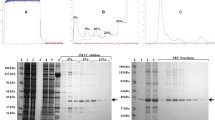Abstract
Methionine aminopeptidase 2 (MAP2) is an essential enzyme that is involved in protein maturation. It plays a key role in the removal of the initiating methionine residue from nascent polypeptide chains. In the present study, a gene encoding methionine aminopeptidase 2 of Schistosoma japonicum (SjMAP2) was cloned and characterized. Real-time RT-PCR and Western blot analysis revealed that this was expressed in each testing developmental stage in S. japonicum, but more highly expressed at 42 days in male adult worm, suggesting this gene as male differentially expressed. The results also showed that the gene was differentially expressed in worms from three different host species. It was highly expressed in worms from the schistosome-susceptible mouse, expressed at a lower level in worms from the less susceptible rat, and at an even lower level in worms from the non-permissive host Microtus fortis. The expression of the gene was affected significantly when the hosts were treated with praziquantel: Expression was down-regulated by 92.17% and 49.01%, respectively, in treated male and female adult worms in comparison with untreated worms. An immuno-experiment in mice indicated that vaccination with recombinant SjMAP2 could induce partial protective efficacy against schistosome infection. The data presented here suggest that SjMAP2 is an important molecule in the development of the schistosome and that it may be a potential new drug target or vaccine candidate for schistosomiasis.






Similar content being viewed by others
References
Boxem M, Tsai CW, Zhang Y, Saito RM, Liu JO (2004) The C. elegans methionine aminopeptidase 2 analog map-2 is required for germ cell proliferation. FEBS Lett 576(1–2):245–250
Chai SC, Ye QZ (2009) Metal-mediated inhibition is a viable approach for inhibiting cellular methionine aminopeptidase. Bioorg Med Chem Lett 19(24):6862–6864
Chen X, Xie S, Bhat S, Kumar N, Shapiro TA, Liu JO (2009) Fumagillin and fumarranol interact with P. falciparum methionine aminopeptidase 2 and inhibit malaria parasite growth in vitro and in vivo. Chem Biol 16(2):193–202
Cheng GF, Lin JJ, Feng XG, Fu ZQ, Jin YM, Yuan CX, Zhou YC, Cai YM (2005) Proteomic analysis of differentially expressed proteins between the male and female worm of Schistosoma japonicum after pairing. Proteomics 5(2):511–521
Cutforth T, Gaul U (1999) A methionine aminopeptidase and putative regulator of translation initiation is required for cell growth and patterning in Drosophila. Mech Dev 82(1-2):23–28
He Y, Luo X, Zhang X, Yu X, Lin J, Li Y, Li Y, Liu S (1999) Immunological characteristics of natural resistance in Microtus fortis to infection with Schistosoma japonicum. Chin Med J 112(7):649–654
Hu X, Addlagatta A, Lu J, Matthews BW, Liu JO (2006) Elucidation of the function of type 1 human methionine aminopeptidase during cell cycle progression. Proc Natl Acad Sci USA 103(48):18148–18153
Kumar S, Tamura K, Nei M (2004) MEGA3: integrated software for Molecular Evolutionary Genetics Analysis and sequence alignment. Brief Bioinform 5(2):150–163
Lee MD, She Y, Soskis MJ, Borella CP, Gardner JR, Hayes PA, Dy BM, Heaney ML, Philips MR, Bornmann WG, Sirotnak FM, Scheinberg DA (2004) Human mitochondrial peptide deformylase, a new anticancer target of actinonin-based antibiotics. J Clin Invest 114(8):1107–1116
Messerli SM, Kasinathan RS, Morgan W, Spranger S, Greenberg RM (2009) Schistosoma mansoni P-glycoprotein levels increase in response to praziquantel exposure and correlate with reduced praziquantel susceptibility. Mol Biochem Parasitol 167(1):54–59
Moertel L, McManus DP, Piva TJ, Young L, McInnes RL, Gobert GN (2006) Oligonucleotide microarray analysis of strain- and gender-associated gene expression in the human blood fluke, Schistosoma japonicum. Mol Cell Probes 20(5):280–289
Pica-Mattoccia L, Cioli D (2004) Sex- and stage-related sensitivity of Schistosoma mansoni to in vivo and in vitro praziquantel treatment. Int J Parasitol 34(4):527–533
Thompson JD, Higgins DG, Gibson TJ (1994) CLUSTAL W: improving the sensitivity of progressive multiple sequence alignment through sequence weighting, position-specific gap penalties and weight matrix choice. Nucleic Acids Res 22(22):4673–4680
Upadhya R, Zhang HS, Weiss LM (2006) System for expression of microsporidian methionine amino peptidase type 2 (MetAP2) in the yeast Saccharomyces cerevisiae. Antimicrob Agents Chemother 50(10):3389–3395
Wang L, Utzinger J, Zhou XN (2008) Schistosomiasis control: experiences and lessons from China. Lancet 372(9652):1793–1795
Wang X, Gobert GN, Feng X, Fu Z, Jin Y, Peng J, Lin J (2009) Analysis of early hepatic stage schistosomula gene expression by subtractive expressed sequence tags library. Mol Biochem Parasitol 166(1):62–69
Acknowledgments
We thank Yao jun Shi, Hao Li, and Ke Lu from the Shanghai Institute of Veterinary Research of the Chinese Academy of Agricultural Sciences for technical assistance with parasite collection. This work was supported by the National Basic Research Program of China (no. 2007CB513108), National Natural Science Foundation of China (no. 30671581), National Key Sciences and Technology Program (2008ZX10004-o11), National High Technology Research and Development Program of China (no. 2006AA10A207), and National Key Technology R&D Program of China (no. 2006BAD06A09).
Author information
Authors and Affiliations
Corresponding authors
Rights and permissions
About this article
Cite this article
Peng, J., Han, H., Hong, Y. et al. Molecular cloning and characterization of a gene encoding methionine aminopeptidase 2 of Schistosoma japonicum . Parasitol Res 107, 939–946 (2010). https://doi.org/10.1007/s00436-010-1956-1
Received:
Accepted:
Published:
Issue Date:
DOI: https://doi.org/10.1007/s00436-010-1956-1




